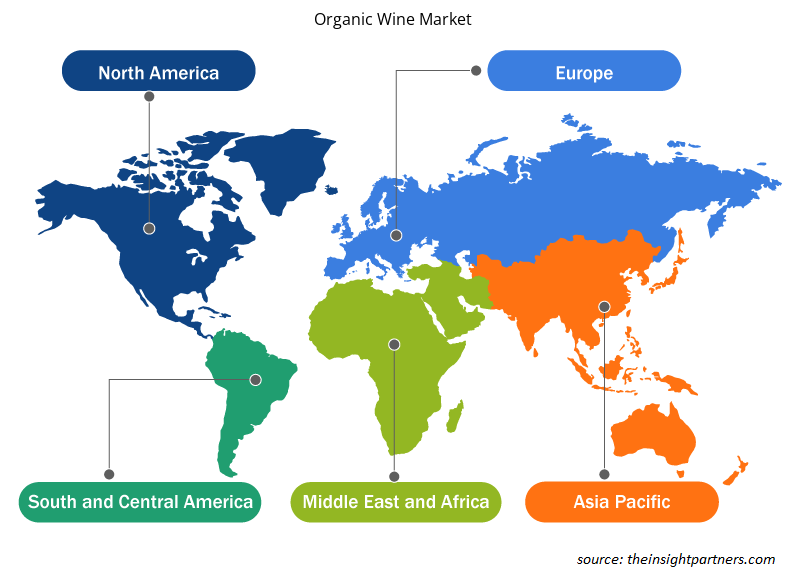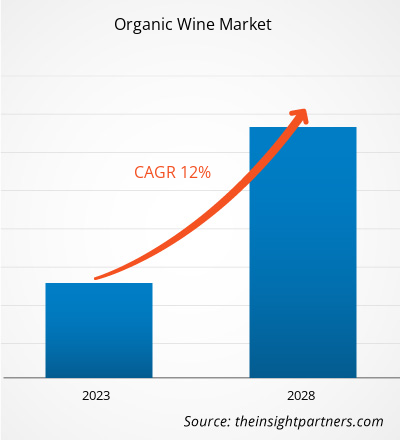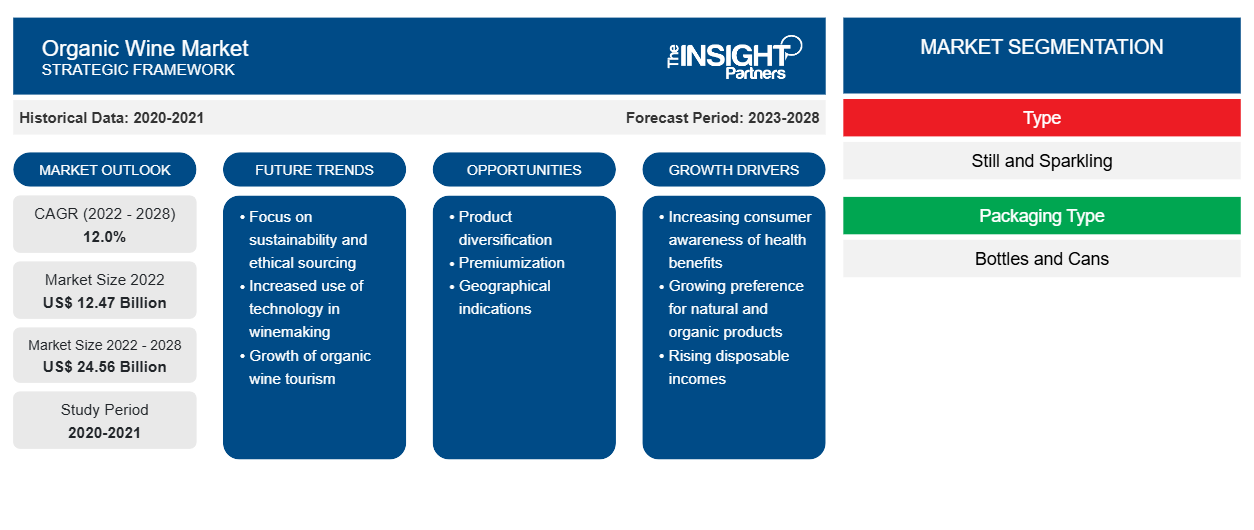Le marché du vin biologique devrait atteindre 24 557,14 millions USD d'ici 2028, contre 12 471,20 millions USD en 2022. Il devrait croître à un TCAC de 12,0 % au cours de la période 2022-2028.
La croissance du marché est attribuée à la préférence croissante des consommateurs pour les aliments et boissons biologiques et durables. De nos jours, les gens ont fait évoluer leurs modes de vie et leurs valeurs sociales, ce qui alimente la demande de boissons biologiques, telles que le vin biologique. La technologie numérique leur permettant d'accéder à divers produits a encore encouragé la demande de vin biologique. Le vin biologique est disponible dans de nombreuses saveurs et emballages ; par exemple, le vin rouge, le vin blanc et le vin rosé sont conditionnés dans des bouteilles et des canettes de différentes tailles, ce qui a augmenté le nombre d'options pour les consommateurs. De plus, le nombre croissant d'initiatives des gouvernements en faveur de l'agriculture durable a conduit à une augmentation de la production de vin biologique. La plus grande disponibilité du vin biologique et la sensibilisation aux avantages du produit contribuent de manière significative à la demande de vin biologique.
En 2021, l'Europe détenait la part clé du marché mondial du vin biologique . Cependant, l'Amérique du Nord devrait enregistrer le TCAC le plus élevé du marché au cours de la période de prévision. Le marché du vin biologique en Amérique du Nord est segmenté entre les États-Unis, le Canada et le Mexique. Les États-Unis font partie des principaux consommateurs de vin en volume. Le pays compte également un nombre croissant de vignobles biologiques et d'importantes importations de vin en provenance d'Europe, selon les données publiées par les Nations Unies.
Personnalisez ce rapport en fonction de vos besoins
Vous bénéficierez d'une personnalisation gratuite de n'importe quel rapport, y compris de certaines parties de ce rapport, d'une analyse au niveau des pays, d'un pack de données Excel, ainsi que de superbes offres et réductions pour les start-ups et les universités.
-
Obtenez les principales tendances clés du marché de ce rapport.Cet échantillon GRATUIT comprendra une analyse de données, allant des tendances du marché aux estimations et prévisions.
Impact de la pandémie de COVID-19 sur le marché des vins biologiques
La pandémie de COVID-19 a considérablement perturbé le secteur manufacturier en termes d'efficacité opérationnelle, en raison des confinements prolongés, des fermetures d'unités de fabrication, des restrictions de voyage, des interdictions de commerce international, des perturbations de la chaîne d'approvisionnement et des pénuries de matières premières. Cela a fini par entraver le marché du vin biologique. La perturbation de l'industrie alimentaire et des boissons due au ralentissement économique provoqué par l'épidémie a également entravé la croissance du marché. Cependant, les entreprises se sont redressées car les restrictions précédemment imposées sont assouplies dans divers pays. La perturbation temporaire suivie d'une reprise a entraîné une forte croissance du marché du vin biologique.
L'introduction de vaccins COVID-19 par les gouvernements de plusieurs pays a encore amélioré la situation, entraînant une augmentation des activités commerciales dans le monde entier. En outre, les gouvernements de plusieurs pays prévoient de développer des infrastructures modernes et technologiquement avancées pour atténuer les impacts économiques de la pandémie de COVID-19. Pendant le confinement, les consommateurs ont acheté du vin eux-mêmes au lieu de l'acheter dans les hôtels, les restaurants et les bars, ce qui a entraîné une forte croissance des ventes de vin biologique. Ainsi, malgré les effets néfastes de la pandémie de COVID-19, le marché du vin biologique devrait connaître une croissance significative dans les années à venir.
Informations sur le marché
Une préférence croissante pour les produits biologiques
Le vin bio est de plus en plus populaire car il est élaboré à partir de raisins conformes aux pratiques de l'agriculture biologique. Les engrais artificiels et chimiques, les fongicides, les insecticides et les herbicides ne sont pas autorisés par les organismes gouvernementaux pour la production. Le vin bio est plus sain car il contient de nombreux antioxydants, vitamines et minéraux. Le resvératrol, présent dans le vin rouge, aide à réduire le cholestérol et à prévenir le cancer. Plusieurs organisations, telles que l'USDA Organic, Demeter et Eco Cert, réglementent et soutiennent la production de vin bio.
Informations basées sur les types
En fonction du type, la taille du marché mondial du vin biologique est divisée en vins tranquilles et vins mousseux. En 2021, le segment tranquille représentait une part de marché plus importante. Cependant, le segment des vins mousseux devrait augmenter à un TCAC plus élevé au cours de la période de prévision. La plupart des vins tranquilles sont élaborés pour être consommés immédiatement, tandis que quelques-uns sont fabriqués pour bénéficier d'un vieillissement en bouteille dans des conditions de cave optimales. Ces vins tranquilles biologiques sont élaborés à partir de jus de raisin qui a été fermenté. De plus, en raison de la disponibilité de différentes variantes avec des épices induites et des odeurs de fruits, le vin tranquille biologique devrait connaître une forte demande. En conséquence, le segment des vins tranquilles biologiques devrait augmenter au cours de la période de prévision.
Avondale, Elgin Ridge Wines, Kendall-Jackson, The Organic Wine Company, Bronco Wine Company, King Estate Winery, Grgich Hills Estate, Emiliana Organic Vineyards, Società Agricola Querciabella Spa et Frey Vineyards sont les acteurs du marché du vin biologique. Ces entreprises proposent une large gamme de produits pour le marché. Elles sont présentes dans les régions en développement, ce qui offre des opportunités lucratives pour le marché. Les acteurs du marché développent des produits innovants et de haute qualité pour répondre aux exigences des clients.
Perspectives régionales du marché du vin biologique
Les tendances régionales et les facteurs influençant le marché du vin biologique tout au long de la période de prévision ont été expliqués en détail par les analystes d'Insight Partners. Cette section aborde également les segments et la géographie du marché du vin biologique en Amérique du Nord, en Europe, en Asie-Pacifique, au Moyen-Orient et en Afrique, ainsi qu'en Amérique du Sud et en Amérique centrale.

- Obtenez les données régionales spécifiques au marché du vin biologique
Portée du rapport sur le marché du vin biologique
| Attribut de rapport | Détails |
|---|---|
| Taille du marché en 2022 | 12,47 milliards de dollars américains |
| Taille du marché d'ici 2028 | 24,56 milliards de dollars américains |
| Taux de croissance annuel composé mondial (2022-2028) | 12,0% |
| Données historiques | 2020-2021 |
| Période de prévision | 2023-2028 |
| Segments couverts |
Par type
|
| Régions et pays couverts |
Amérique du Nord
|
| Leaders du marché et profils d'entreprises clés |
|
Densité des acteurs du marché du vin bio : comprendre son impact sur la dynamique commerciale
Le marché du vin biologique connaît une croissance rapide, stimulé par la demande croissante des utilisateurs finaux en raison de facteurs tels que l'évolution des préférences des consommateurs, les avancées technologiques et une plus grande sensibilisation aux avantages du produit. À mesure que la demande augmente, les entreprises élargissent leurs offres, innovent pour répondre aux besoins des consommateurs et capitalisent sur les tendances émergentes, ce qui alimente davantage la croissance du marché.
La densité des acteurs du marché fait référence à la répartition des entreprises ou des sociétés opérant sur un marché ou un secteur particulier. Elle indique le nombre de concurrents (acteurs du marché) présents sur un marché donné par rapport à sa taille ou à sa valeur marchande totale.
Les principales entreprises opérant sur le marché du vin biologique sont :
- La société Kellogg
- Avondale
- Vins d'Elgin Ridge
- Kendall Jackson
- La Compagnie des Vins Biologiques
Avis de non-responsabilité : les sociétés répertoriées ci-dessus ne sont pas classées dans un ordre particulier.

- Obtenez un aperçu des principaux acteurs du marché du vin biologique
Rapports en vedette
- Tendances progressistes de l'industrie sur le marché des vins biologiques pour aider les acteurs à développer des stratégies efficaces à long terme
- Stratégies de croissance des entreprises adoptées par les marchés développés et en développement
- Analyse quantitative du marché du vin bio de 2020 à 2028
- Estimation de la demande mondiale en vins bio
- Analyse des cinq forces de Porter pour illustrer l'efficacité des acheteurs et des fournisseurs opérant dans l'industrie
- Développements récents pour comprendre le scénario concurrentiel du marché
- Tendances et perspectives du marché et facteurs qui stimulent et freinent la croissance du marché des vins biologiques
- Aide à la prise de décision en mettant en évidence les stratégies de marché qui sous-tendent l'intérêt commercial, conduisant à la croissance du marché
- La taille du marché des vins biologiques à différents niveaux
- Aperçu détaillé et segmentation du marché, ainsi que de la dynamique du secteur des vins biologiques
- Taille du marché des vins biologiques dans différentes régions avec des opportunités de croissance prometteuses
L'analyse du marché mondial du vin biologique jusqu'en 2028 est une étude spécialisée et approfondie de l'industrie des aliments et des boissons, avec un accent particulier sur l'analyse des tendances du marché mondial du vin biologique. Le rapport vise à fournir un aperçu du marché avec une segmentation détaillée du marché.
Le marché du vin biologique est segmenté en type, type d'emballage, canal de distribution et géographie. En fonction du type, le marché est divisé en vins tranquilles et mousseux. En fonction du type d'emballage, le marché est divisé en bouteilles et canettes. En fonction du canal de distribution, le marché est segmenté en supermarchés et hypermarchés, magasins spécialisés, vente au détail en ligne et vente directe. Par géographie, le marché est largement segmenté en Amérique du Nord, Europe, Asie-Pacifique (APAC), Moyen-Orient et Afrique (MEA) et Amérique du Sud et centrale.
Profils d'entreprise
- Avondale
- Vins d'Elgin Ridge
- Kendall Jackson
- La Compagnie des Vins Biologiques
- Entreprise vinicole Bronco
- Domaine viticole King Estate
- Domaine des collines de Grgich
- Vignobles biologiques Emiliana
- Société Agricola Querciabella Spa
- Vignobles Frey
- Analyse historique (2 ans), année de base, prévision (7 ans) avec TCAC
- Analyse PEST et SWOT
- Taille du marché Valeur / Volume - Mondial, Régional, Pays
- Industrie et paysage concurrentiel
- Ensemble de données Excel
Rapports récents
Rapports connexes
Témoignages
Raison d'acheter
- Prise de décision éclairée
- Compréhension de la dynamique du marché
- Analyse concurrentielle
- Connaissances clients
- Prévisions de marché
- Atténuation des risques
- Planification stratégique
- Justification des investissements
- Identification des marchés émergents
- Amélioration des stratégies marketing
- Amélioration de l'efficacité opérationnelle
- Alignement sur les tendances réglementaires























 Obtenez un échantillon gratuit pour - Marché aux vins bio
Obtenez un échantillon gratuit pour - Marché aux vins bio